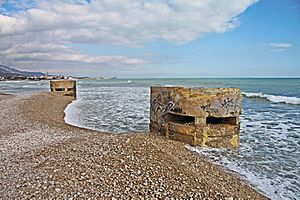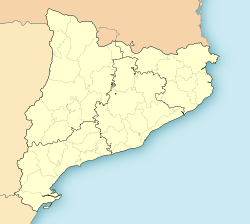Alcanar facts for kids
Quick facts for kids
Alcanar
|
|||
|---|---|---|---|
|
Municipality
|
|||

Alcanar's harbour
|
|||
|
|||
| Country | |||
| Autonomous community | |||
| Province | Tarragona | ||
| Comarca | Montsià | ||
| Area | |||
| • Total | 47.1 km2 (18.2 sq mi) | ||
| Elevation | 72 m (236 ft) | ||
| Population
(2018)
|
|||
| • Total | 9,402 | ||
| • Density | 199.62/km2 (517.0/sq mi) | ||
| Demonym(s) | canareus | ||
| Time zone | UTC+1 (CET) | ||
| • Summer (DST) | UTC+2 (CEST) | ||
| Postal code |
43530
|
||
Alcanar is a lovely coastal town in Catalonia, Spain. It's located right on the Mediterranean Sea, which means it has beautiful beaches. The town is part of the Montsià area in the Tarragona province. It is the southernmost town in Catalonia. The Serra del Montsià mountains rise above the town. In 2018, about 9,402 people lived in Alcanar.
Contents
Villages in Alcanar
Alcanar is made up of a few smaller villages:
- Alcanar, which is the main town with about 7,494 people.
- Alcanar-Platja, with 988 people.
- Les Cases d'Alcanar, with 1,391 people.
- La Selleta, with 96 people.
History of Alcanar
Alcanar has a long history, even though it became an independent town only in the 1400s. Before that, it was part of another area called Ulldecona starting from 1148.
Early Beginnings
The town officially got its first special document, called a charter, in 1239. This document helped set up the town. However, things really became stable when a new charter was given in 1252. This date is seen as the true start of Alcanar as a town.
By 1380, about 30 families lived here. They faced many attacks from Saracen pirates. To protect themselves, people built a lookout tower in the 1300s. The town also built walls to keep safe. In 1449, Alcanar finally became fully independent from Ulldecona.
Wars and Defenses
During a war against John II of Castile, the king's soldiers took over Alcanar and burned parts of it. Later, when King Philip II was in charge, more defense towers were built. These towers helped protect the town from Turkish pirates. Alcanar was also fortified again with stronger walls.
In the Reapers' War (1640-1659), Alcanar stayed loyal to the king of Castile. Because of this, Catalan troops occupied the town. Something similar happened during the Peninsular War. Later, during the First Carlist War, the town was attacked. Soldiers from the Carlist side captured and looted Alcanar. They held a strong position in the town for some time.
Modern Events
On July 11, 1978, a very sad event happened near Alcanar. A large truck carrying a flammable liquid exploded near a campsite called Camping de los Alfaques. This tragic accident caused many deaths and injuries.
On August 16, 2017, there was an explosion in a house outside the town. Two people died and one was injured. The next day, another explosion happened. It was later discovered that the people involved were making bombs. These bombs were meant for the 2017 Barcelona attacks that happened shortly after.
Culture and Landmarks
Alcanar has several important cultural sites.
Saint Michael's Church
The main church in Alcanar is dedicated to Saint Michael (Sant Miquel). It's a very important building in the town. The church was built in the Renaissance style. It has a single main area and smaller chapels on the sides. Over the years, it has been expanded and changed. Today, it is 19 meters wide and 16 meters tall. The entrance has an arch framed by columns. The belltower is square with windows on each side.
Our Lady of Good Remedy Shrine
Outside the main village, there is a special shrine dedicated to the Mare de Déu del Remei (Our Lady of Good Remedy). It was built in the late 1500s and early 1600s in a Gothic style. In the 1700s, a belltower and a dome were added, and the inside was made larger.
Next to the shrine, there used to be a guest house. It still has a mosaic that shows the battle of Lepanto. This mosaic was once part of the chapel floor but was moved. The image of Our Lady of Good Remedy inside the shrine is a small statue from the 1700s. The inside of the temple has paintings from 1920. Sadly, some old altarpieces and decorations were destroyed in 1936.

Coastal Defense Towers
Along the coast, you can see old defense towers. These towers were built between 1530 and 1630. Their purpose was to protect the area from pirate attacks. Most of these towers are square with arched doorways. Many of them have been fixed up and are now used as homes or summer houses.
Economy and Tourism
Tourism is a big part of Alcanar's economy, especially during the summer.
Tourism and Housing
Near Alcanar Beach, many new homes have been built. These homes are often used by tourists during the summer months. One of the oldest summer homes is called Clos de Codorniu. It was once a home for King Alfonso XIII of Spain. Alcanar also has hotels, campsites, and other places for tourists to stay.
Many tourists prefer to stay in the quiet fishing village of Les Cases d'Alcanar or in Alcanar-Platja. The small village of La Selleta was built by German people on a hill in the last half of the 20th century.
Agriculture and Fishing
Farming is still important in the northern part of the town, further from the coast. Farmers mainly grow oranges and clementines. Fishing is also very important in Alcanar's smaller villages. They are especially known for catching prawns.
Port of Alcanar
The Port of Alcanar is a facility that serves a cement factory located on the south side of the town.
See also
 In Spanish: Alcanar para niños
In Spanish: Alcanar para niños






